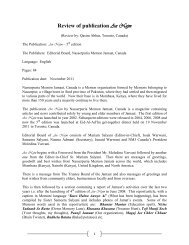August 2011 Final Pages.indd - World Memon Organization ...
August 2011 Final Pages.indd - World Memon Organization ...
August 2011 Final Pages.indd - World Memon Organization ...
Create successful ePaper yourself
Turn your PDF publications into a flip-book with our unique Google optimized e-Paper software.
HEALTH MATTERS<br />
The 8 Germiest<br />
Public Places<br />
An average adult can touch as many as 30 objects within a minute, including<br />
germ-harboring, high-traffic surfaces such as light switches, doorknobs, phone<br />
receivers, and remote controls. At home, you do all that you can to keep the<br />
germs at bay. But what happens when you step out the door to go to dinner,<br />
do some grocery shopping, or visit the doctor’s office? Know where germs are<br />
most likely to lurk, as you’ll find out here.<br />
1. Restaurant menus<br />
Have you ever seen anyone wash off a<br />
menu? Probably not. A recent study in<br />
the Journal of Medical Virology reported<br />
that cold and flu viruses can survive for<br />
18 hours on hard surfaces. If it’s a popular<br />
restaurant, hundreds of people could<br />
be handling the menus–and passing their<br />
germs on to you. Never let a menu touch<br />
your plate or silverware, and wash your<br />
hands after you place your order. Or use<br />
antibacterial wipes.<br />
2. Lemon wedges<br />
According to a 2007 study in the Journal<br />
of Environmental Health, nearly 70% of<br />
the lemon wedges perched on the rims of<br />
restaurant glasses contain disease-causing<br />
microbes. When the researchers ordered<br />
drinks at 21 different restaurants, they<br />
found 25 different microorganisms lingering<br />
on the 76 lemons that they secured,<br />
including E. coli and other fecal bacteria.<br />
Tell your server that you’d prefer your<br />
beverage sans fruit. Why risk it?<br />
Drinking lemon water instead of soda is<br />
a good weight loss strategy. But you don’t<br />
have to ditch your diet just because you’re<br />
eating out.<br />
3. Condiment dispensers<br />
It’s the rare eatery that regularly bleaches<br />
its condiment containers. And the reality<br />
is that many people don’t wash their hands<br />
before eating, says Kelly Reynolds, PhD.<br />
So while you may be diligent, the guy who<br />
poured the ketchup before you may not<br />
have been, which means his germs are now<br />
on your fries. Squirt hand sanitizer on the<br />
outside of the condiment bottle or use a<br />
disinfectant wipe before you grab it. Holding<br />
the bottle with a napkin won’t help;<br />
napkins are porous, so microorganisms can<br />
pass right through, Reynolds says.<br />
4. Restroom door handles<br />
Don’t think you can escape the restroom<br />
without touching the door handle? Palm<br />
a spare paper towel after you wash up<br />
and use it to grasp the handle. Yes, other<br />
patrons may think you’re a germphobe–but<br />
you’ll never see them again, and you’re the<br />
one who won’t get sick.<br />
5. Soap dispensers<br />
About 25% of public restroom dispensers<br />
are contaminated with fecal bacteria. Soap<br />
that harbors bacteria may seem ironic,<br />
but that’s exactly what a recent study<br />
found. “Most of these containers are never<br />
cleaned, so bacteria grow as the soap scum<br />
builds up,” says Charles Gerba, PhD. “And<br />
the bottoms are touched by dirty hands, so<br />
there’s a continuous culture feeding millions<br />
of bacteria.” Be sure to scrub hands<br />
thoroughly with plenty of hot water for 15<br />
to 20 seconds–and if you happen to have<br />
an alcohol-based hand sanitizer, use that,<br />
too.<br />
6. Grocery carts<br />
The handles of almost two-thirds of the<br />
shopping carts tested in a 2007 study at the<br />
University of Arizona were contaminated<br />
with fecal bacteria. In fact, the bacterial<br />
counts of the carts exceeded those of the<br />
average public restroom. Swab the handle<br />
with a disinfectant wipe before grabbing<br />
hold (stores are starting to provide them,<br />
so look around for a dispenser). And while<br />
you’re wheeling around the supermarket,<br />
skip the free food samples, which are nothing<br />
more than communal hand-to-germ-tomouth<br />
zones.<br />
7. Airplane bathrooms<br />
When Gerba tested for microbes in the<br />
bathrooms of commercial jets, he found<br />
surfaces from faucets to doorknobs to be<br />
contaminated with E. coli. It’s not surprising,<br />
then, that you’re 100 times more likely<br />
to catch a cold when you’re airborne,<br />
according to a recent study in the Journal<br />
of Environmental Health Research.<br />
To protect yourself, try taking green tea<br />
supplements. In a 2007 study from the<br />
University of Florida, people who took a<br />
450-milligram green tea supplement twice<br />
a day for 3 months had one-third fewer<br />
days of cold symptoms.<br />
8. Doctor’s office<br />
A doctor’s office is not the place to be if<br />
you’re trying to avoid germs. These tips<br />
can help limit your exposure:<br />
1. Take your own books and magazines<br />
(and kid’s toys, if you have your children<br />
or grandchildren with you).<br />
2. Also pack your own tissues and hand<br />
sanitizers, which should be at least 60%<br />
alcohol content.<br />
3. In the waiting room, leave at least two<br />
chairs between you and the other patients<br />
to reduce your chances of picking up their<br />
bugs. Germ droplets from coughing and<br />
sneezing can travel about 3 feet before falling<br />
to the floor.<br />
MEMON ALAM AUGUST <strong>2011</strong> 37
















